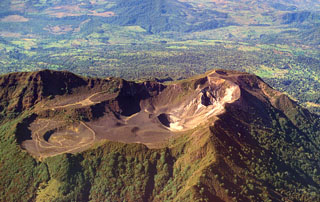Report on Turrialba (Costa Rica) — 20 July-26 July 2016
Smithsonian Institution / US Geological Survey
Weekly Volcanic Activity Report, 20 July-26 July 2016
Managing Editor: Sally Sennert.
Please cite this report as:
Global Volcanism Program, 2016. Report on Turrialba (Costa Rica) (Sennert, S, ed.). Weekly Volcanic Activity Report, 20 July-26 July 2016. Smithsonian Institution and US Geological Survey.
Turrialba
Costa Rica
10.025°N, 83.767°W; summit elev. 3340 m
All times are local (unless otherwise noted)
OVSICORI-UNA reported that an explosion at Turrialba recorded at 1309 on 22 July generated an ash plume that rose 800 m and drifted W. Increased tremor coincided with the event. Ash-and-gas emissions rose from the crater for approximately 15 minutes, starting at 1543. Ash emissions were recorded with the webcam at 0600 on 23 July. Tremor levels fluctuated though the day; periods of increased tremor likely corresponded to ash emissions. Visual observations of the crater were hindered by fog. Tremor amplitude increased at 1800 on 24 July. Two explosions, at 2123 and 2217, ejected hot rock fragments, gas, and ash 500 m above the crater; the gas-and-ash plume drifted SW. Gas-and-ash emissions passively rose from the crater through the next morning. At 0722 on 25 July an explosion generated an ash plumes that rose 3 km above the crater and drifted NW, W, and SW. At 0826 another explosion produced an ash plume that rose 1.5 km.
Geological Summary. Turrialba, the easternmost of Costa Rica's Holocene volcanoes, is a large vegetated basaltic-to-dacitic stratovolcano located across a broad saddle NE of Irazú volcano overlooking the city of Cartago. The massive edifice covers an area of 500 km2. Three well-defined craters occur at the upper SW end of a broad 800 x 2200 m summit depression that is breached to the NE. Most activity originated from the summit vent complex, but two pyroclastic cones are located on the SW flank. Five major explosive eruptions have occurred during the past 3500 years. A series of explosive eruptions during the 19th century were sometimes accompanied by pyroclastic flows. Fumarolic activity continues at the central and SW summit craters.
Source: Observatorio Vulcanologico y Sismologico de Costa Rica-Universidad Nacional (OVSICORI-UNA)

